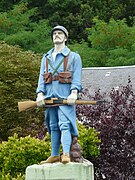Charles-Henri Pourquet
Charles-Henri Pourquet | |
|---|---|
 Pourquet in his studio, 1912 | |
| Born | Henri Charles Justin Pourquet 14 August 1877 Colombes, France |
| Died | 1943 |
| Occupation | sculptor |
Charles-Henri Pourquet, born Henri Charles Justin Pourquet (14 August 1877 – 1943) was a French sculptor.
Life
[edit]Born in Colombes, the son of a baker, Pourquet had Nivernais origins and was a student of Louis-Ernest Barrias and Jules Coutan at the École des beaux-arts de Paris.[1] In 1907, he became a member of the Société des artistes français
He was successful after the First World War, with sculptures of Poilus that served as models for many war memorials in France[2] under three different models: Bust, Poilu, and more particularly the one entitled Resistance, of which several hundred copies will be cast by the Fonderie d'art du Val d'Osne.[3]
Among other works, is "Orpheus at the tomb of Eurydice", a bas-relief which will then be acquired by the State for the new National Conservatory of Music,[4] a monument dedicated to Jules Renard in Chitry-les-Mines (Nièvre)[4] where the writer lived as a child, and the Tombeau de la famille Sabaterie, in the Arlanc (Puy-de-Dôme) cemetery.[4] He remarried at the town hall of the 18th arrondissement on 5 November 1921, with Valentine Saint-Selve.
For a long time, Pourquet had his workshop at Les Fusains, an artists community located at 22 rue Tourlaque[5] in Montmartre, in the 18th arrondissement.
Awards
[edit]- Chevalier of the Légion d'honneur in 1931.
- Gold medal at the 1929 Salon.
Salons
[edit]- Salon des artistes français:
- 1925: Maréchal Sérurier, stone statue, commissioned by the State.
- 1928: Statue de mon jeune ami Jean Le Blond, plaster; Tristesse, terracotta statuette.
- 1935: M. Renaitour, député-maire d'Auxerre, plaster, M. Ortiz, président des Amis de la Légion.
Works
[edit]- Chitry: Monument to Jules Renard , destroyed in 1942.
- Lormes: Résistance, Poilu blocking the enemy's way, at the top of the War Memorial.
-
Monument aux morts,
Jou-sous-Monjou. -
Monument aux morts,
Savignac-les-Églises.
Critical reception
[edit]- In May 1919, the magazine L'Art funéraire devoted a complimentary article to him with a photograph on the front page. Each issue, since its publication, has been used to advertise him and describes him as a "statuary of pain".
References
[edit]- ^ Stéphane Richemond (2008). Les orientalistes; dictionnaire des sculpteurs, XIXe-XXe siècles. les éditions de l'Amateur. p. 178. ISBN 9782859174842.
- ^ Thierry Lemoine; Stéphanie Claisse (2005). Comment (se) sortir de la Grande guerre ?. Paris: L'Harmattan. ISBN 9782747592079.
- ^ "POURQUET Charles-Henri- Sculpteur". Les monuments aux morts. Archived from the original on 19 September 2016. Retrieved 7 February 2019.
- ^ a b c Maurice Le Blond. L'œuvre de M. Charles-Henri Pourquet, statuaire. Paris. Archived from the original on August 16, 2016..
- ^ "L'Art funéraire et commémoratif, June 1922". Archived from the original on 2016-03-15. Retrieved 2019-02-07.
Bibliography
[edit]- Benezit Dictionary of Artists
- André Roussard, Dictionnaire des peintres à Montmartre, Paris, éditions Roussard, 1999, p. 486.
- Bernard Morot-Gaudry, La sculpture en Morvan au XXe siècle et début du XXIe, 2017, Éditions Académie du Morvan, bulletin No. 82, p. 17-18.
- Maurice Le Blond, L'Œuvre de Charles-Henri Pourquet, statuaire, 1921.
External links
[edit]- POURQUET Charles-Henri
- Les œuvres commémoratives du sculpteur Pourquet
- Monuments aux morts de Normandie et d'ailleurs


